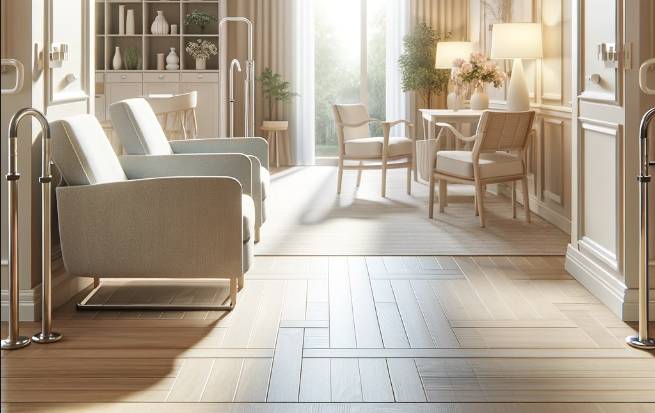“Aging in Place for Seniors | Home Health Care for the Elderly” emphasizes the importance of adapting living spaces to meet the needs of the elderly.
As the global population ages, the concept of aging in place has become a central discussion point for seniors, their families, and policymakers alike.
The desire to grow old in one’s own home, surrounded by familiar settings and memories, is a universally shared aspiration.
This article discusses the essence of aging in place, exploring its advantages over traditional senior living options. It provides a comprehensive guide on creating a safe, supportive, and financially sustainable environment for seniors wishing to live independently for as long as possible.

Understanding the Concept of Aging in Place
Defining “Aging in Place” in the context of senior living: Aging in place allows seniors to remain in their own homes as they age, instead of moving to assisted living facilities or nursing homes.
This approach emphasizes adapting the living environment to meet their changing needs. As a consequence, it enables them to maintain their independence and quality of life.
The goal is to create a safe, comfortable space that accommodates their health and mobility needs over time, regardless of age, income, or ability level.
The importance of familiarity and comfort for seniors at home: Many seniors prefer familiar surroundings as it provides a sense of security and belonging. As such, it contributes to their emotional and psychological well-being.
Furthermore, being in a known environment can help maintain cognitive functions and offers a continuity of personal history that is often lost in relocation.
Additionally, comfort in one’s home includes the ability to navigate the space easily. Therefore, it requires a user-friendly design that caters to the senior’s evolving physical abilities.
Emotional and physical benefits of staying in a familiar environment: Moreover, staying at home can lead to improved mental health. As a result, it may lead to lower rates of depression and anxiety compared to those who move to institutional settings.
Physically, seniors can benefit from the customization of their space to suit their specific health needs, promoting safer mobility and reducing the risk of falls. Moreover, the emotional stability provided by a familiar environment can lead to better overall health outcomes.
Comparisons with alternative senior living options: Aging in place offers a stark contrast to other senior living arrangements by prioritizing personal preference, familiarity, and independence.
While assisted living and nursing homes provide necessary medical care and structured environments, they often do so at the expense of individuality and autonomy.
Aging in place keeps seniors in their community, facilitating continued social connections and engagement with their usual social activities and networks.
The Essentials of Creating a Safe Home Environment
Home modifications and renovations for safety: Ensuring a safe home environment is paramount for aging in place to be a viable option.
This includes:
- Installing ramps for wheelchair access.
- Also, modifying bathrooms with walk-in showers and grab bars.
- And, ensuring that the home is easily navigable without stairs.
Flooring may need to be replaced to reduce slip hazards, and additional lighting installed to aid visibility.
Smart home technology that assists aging in place: This can also play a significant role including enhancing communication with family members and healthcare providers.
Such technologies can significantly enhance the safety and independence of seniors living at home. These include:
- Medical alert systems,
- Automated lighting.
- Voice-activated devices.
- And remote health monitoring tools.
They can help manage medication schedules, detect falls, and even monitor vital signs, providing peace of mind for both seniors and their caregivers.
Day-to-day tools and aids for independent living: Such tools, alongside thoughtful accessibility design in the home, further empower seniors to maintain their independence.
These adaptations not only make daily tasks more manageable but also help in preserving the dignity of seniors as they navigate the challenges of aging. Some examples are reachers, non-slip mats, adaptive kitchen utensils, and dressing aids.
These aids help maintain independence in personal care, cooking, and household chores, critical aspects of aging in place successfully.
Importance of accessibility in design: A home designed with accessibility in mind can accommodate mobility devices. For example, walkers and wheelchairs, and adapt to the changing needs of its occupants.
This means wider doorways, lever-style door handles, and lower countertops. Such designs not only benefit seniors but also any visitors or residents with disabilities. Subsequently, it ensures the home is welcoming and functional for everyone.
Support Systems and Community Resources
Furthermore, the success of aging in place heavily relies on robust support systems and accessible community resources.
Role of family and friends in supporting aging in place: Family and friends play an indispensable role. For instance, they can offer emotional support and assistance with practical tasks.
The involvement of a supportive network is crucial in enabling seniors to live independently. This support can range from assistance with daily tasks to regular social visits, helping to reduce feelings of isolation.
For example, they can play a key role in coordinating care and services needed to support the senior’s desire to age in place.
Local community services and programs for seniors: Similarly, local community services and programs can provide social engagement opportunities tailored to seniors.
Many communities offer meal delivery, transportation services, home health care, and social activities.
These programs not only assist with practical needs but also provide opportunities for social interaction, which is vital for maintaining mental health and well-being.
Professional caregiving options and how to choose the right one: These options are also available when family support is not enough. Options range from part-time home health aides to live-in caregivers, depending on the level of need.
Choosing the right type of care involves assessing the senior’s needs, preferences, and financial situation.
Leveraging technology for healthcare and social connections: Additionally, technology has become a critical tool, enabling seniors to access healthcare services remotely and maintain social connections, thus combating isolation.
Social media and video calling platforms can help maintain social ties, combating loneliness and keeping seniors engaged with their communities and families.
For example, telehealth services allow seniors to consult with healthcare providers without leaving home.

Navigating the Financial Aspects of Aging in Place
Cost comparison | Aging in place vs. assisted living facilities: Financial considerations are a critical aspect of planning for aging in place.
While staying at home can be perceived as less costly compared to assisted living facilities, it does come with its own set of expenses. This includes home modifications, maintenance, and caregiving services.
On the other hand, the initial costs for modifying a home for aging in place might seem high. However, they often pale in comparison to the ongoing costs of assisted living facilities.
A detailed cost-benefit analysis can help families make informed decisions based on long-term financial sustainability.
Financial planning tips for long-term independent living: Seniors and their families must engage in careful financial planning to ensure long-term sustainability.
Therefore, it’s essential to create a comprehensive financial plan that accounts for potential increases in healthcare costs, home maintenance, and caregiving services.
This might include setting aside savings, investing in long-term care insurance, or exploring reverse mortgage options for additional income.
Available government aids and grants for seniors: Government aids and grants can offer much-needed financial support. For instance, they can cover some of the costs associated with home adaptations and care services.
Various government programs can help offset the costs associated with aging in place. These might include Medicare or Medicaid benefits, veterans’ benefits, and grants for home modifications.
So, familiarizing oneself with these options can provide significant financial relief.
Insurance and healthcare costs: It’s also important to understand the insurance and healthcare costs involved, as these can significantly impact a senior’s ability to remain at home.
This includes navigating Medicare benefits, supplemental insurance, out-of-pocket expenses for prescription drugs, medical equipment, and home health services.
Finally, planning for these costs is an integral part of ensuring that aging in place remains a viable and sustainable option.
Conclusion | Aging in Place for Seniors
Aging in place represents a shift in how society views senior living, emphasizing the value of independence, comfort, and the emotional bonds tied to one’s home.
By understanding and addressing the practicalities of safety, support systems, and financial planning, seniors can enjoy a quality of life in their later years that aligns with their preferences and values.
The journey of aging in place is not without its challenges. However, with the right preparation and resources, it is a deeply rewarding path that honors the dignity and desires of seniors, allowing them to age gracefully in the place they call home.
What are your concerns about this topic, “Aging in Place for Seniors | Home Health Care for the Elderly”?
Please feel free to share your thoughts, questions, or comments below. I’d love to hear from you and will be happy to respond.
Veron | Entrepreneur | The Way 4WordEnterprises
Personal Recommended Resources:
Another Daughter TM | A senior care service for independent Seniors living in or around Raleigh, NC
